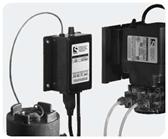3.1: Control Systems - Measurement Devices
- Page ID
- 22551
Control Systems: Industrial Applications
Many control systems are used today in a large number of industries consisting of applications from all kinds. The common factor of all control types is to sustain a desired outcome that may change during a chemical reaction or process. The most common control type used today in industry is a PID controller (proportional, integral, derivative), which allows the operator to apply different control techniques that can be used to achieve different settings in an experiment or process. A PID controller can be used in two main control mechanisms that include feed back and feed forward. The purpose of this article is to provide examples of common industrial control systems that apply different control architectures.
Temperature control: Thermocouple
A thermocouple is a device to measure and control temperature within a system. They are used in a wide variety of industrial applications (gas turbines, chemical reactors, exhaust, chemical manufacturing etc) due to their low cost and portability. The fundamental working principle for thermocouple operations is the Seebeck Effect. Mostly, thermocouples operate in a P or a PID control mode. In order to measure temperature between two points, the thermocouple employs two metallic ends (made from different alloys). When the two conductor ends are exposed to a thermal gradient, they generate a voltage between them. This voltage drop gives rise to the temperature measurement output that a thermocouple provides. Depending on the types of alloys in both conductor ends, and the magnitude of the thermal gradient, thermocouples can measure temperature differences between 1-23000C. They can operate in feedback loops or feed forward loops. Thermocouples are mostly digital control units. Thermocouple prices started around $100 and cost up to $2500 for more accurate, and self-calibrated models.

Pressure Control: Pressure Switch
A pressure switch is a device that controls systems against pressure drops or pressure spikes. The most basic types of pressure switches work on an ON-OFF basis, but can also be manufactured to work in PID mode. The fundamental method of operation is to set the “Set-Pressure” to a given quantity. This deactivates the pressure switch from the circuit connecting it to the control valve upstream. If, at any point during the process, the pressure rises past the set-point, the switch is activated and completes the circuit, thus shutting off the control valve. Pressure switches can be hydraulic, or pneumatic based (air-based pressure). One common application of a pressure switch in the industry is to protect PD (positive-displacement) pumps from over-pressurization. A PD pump can generate very high pressures if not controlled by a pressure switch; thus setting a pressure switch inline with a PD pump will prevent over pressurization since it shuts off the control valve. Pressure switches are common in any industry since all require pressurization of certain components during manufacturing, processing or refining stages. They sell between $200-$2000 depending on the magnitude of the set-point required for protection.

Composition Control: Ratio Control
A ratio controller is used to ensure that two or more process variables such as material flows are kept at the same ratio even if they are changing in value. Control modes can be operated in different types, but mostly feedback PI controller is used for ratio control. In industrial control processes, ratio control is used in the following processes: burner/air ratio, mixing and blending two liquids, injecting modifiers and pigments into resins before molding or extrusion, adjusting heat input in proportion to material flow. The prices for industrial ratio controllers start around $500 and increase depending on the sensitivity of the unit to different magnitudes of compositional changes and size of the equipment to be annexed to.

Level Control: Level Switches
Level controls are used to monitor and regulate the liquid level in industrial vessels. There are many various sensors used in level control including ultrasonic, lasers, and floatation sensors. They all work on the same general principle. A sensor measures the distance from the base of the vessel to the top of the liquid level, mainly by using sonar waves or a laser beam. Based on the time it takes for the wave or for the laser beam to return to the emitting source, the controller sends information to change or maintain the level. The magnetic float control reads on a sensor located on the wall of the vessel and sends that information to the controller. Some examples of level control in industry are: maintaining the liquid level in a distillation column, protecting from overflow, and measuring the amount of product in storage tanks. Level sensors/controls vary in price based on the type and the accuracy required. Below is a picture of a magnetic float level control.

Flow Control: Flow Meters
Flow controls are used to regulate the flow of a liquid or gas through a system. The main form of flow control is a valve. There are many different types of valves, but they all change flow rates by opening or closing based on what amount is needed. A flow sensor reads the flow rate, and a controller will operate the valve to increase or decrease the flow. Some basic types of flow sensors are rotameters and digital mass meters. These controls are used in all forms of industry to control flows including water treatment, product measurement, and fuel flow to furnaces. The low price end for flow sensors is typically around $500, and depending on the size of the process, and the process material, the price can range into the thousands. Below are two pictures. The first is a manual control valve that can be opened or shut to regulate flow. The second is a valve that can be used in an automatic control system to regulate flow.


Contributors and Attributions
- Christian Hatfield, Varun Kaushik, Alon Mandel


